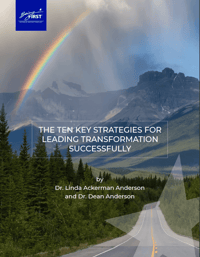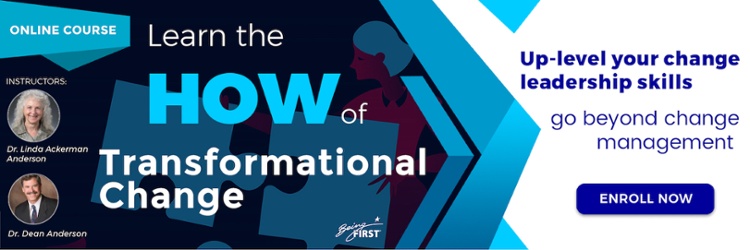The journey of organizational change – especially transformation – is anything but a straight line. If you are making changes that are transformational, it is likely things will be unruly, unpredictable, and messy in the process. Because of this uncertainty, the best course of action is to plan your change and future state as best you can, and then establish a mechanism and process to course correct your plans and outcomes as you discover the need to do so. Transformational leadership is not about sticking to the rigid intention of “make the Plan; follow the Plan!”
Why Transformational Change Is So Uncertain
Transformational change is full of uncertainty because:
- The organization begins its change process before the future state solution is known. The change process is designed to discover the best desired state with the input of experts and stakeholders who have insight into what is needed and will work.
- Proceeding without a well-defined destination requires heading into the unknown, which makes most people uncomfortable. You will be letting people know that their world will be changing, but not giving them a clear idea of what it is changing into, or what will be required of them. Inevitably, people will feel insecure, and resistance may rise. In the face of this uncertainty, their commitment to change and performance levels become unpredictable, so the need to deal with these human dynamics becomes critical. No matter how much you plan, these human reactions will occur and require adjustments to your change plan.
- Until you clarify your future state design, there is no way of knowing in advance the pace or actual scope of work that will be required, which will undoubtedly grow as you proceed.

This model portrays the journey of transformation. This dynamic process cannot be effectively managed by project management where the tools and steps are too rigid as the backbone for guiding an emergent transformational change process.
Like in sailing, the transformational path is not a straight line between the current reality and your vision of the future state. It makes innumerable turns as leaders monitor what is known, what is emerging, and what the best outcome and path should be.
Managing the Unpredictable
As a CEO leading transformational change, you can’t tightly control the unpredictable and emergent process. At best, you can facilitate it.
- Be clear on your intended direction, and then give up any expectation of controlling the change process or pressuring it into a pre-determined timeline or scope.
- Actively pursue information and feedback that help you discover the need to alter your desired outcome or course of action.
- Optimize your ability to learn from the feedback you gather and turn that learning into appropriate, rapid course corrections. Learning and course correcting are essential for transformational success.
Making Learning and Course Correcting a Reality
Most of us tend to see deviation from our change plan as a problem. In organizational transformation, deviation is never the problem. The issue is always how quickly we can spot a need to course correct, then learn from the situation and change course. The better and faster your organization is at learning and course correcting – as individuals, teams, and a whole system – the smaller (and less costly) the adjustments need to be. Think agile! Promote “Getting Smarter by the Day!”
Developing expertise at learning and course correcting requires a significant change of mindset for most leaders and employees, which must be supported by appropriate shifts in cultural norms that inhibit it. In many organizations, the messengers of “bad news” get criticized. Making a mistake is detrimental to a person’s career. These cultural norms stand directly in the way of succeeding in transformation. To increase your organization’s change capability, you must build a culture where people are not blamed for making or surfacing “mistakes” but are held accountable for learning from and fixing them.
Consider these cultural norms. If they are present in your organization, they will inhibit your ability to succeed, at least in a timely way.
- Too many layers of approval required in the chain of command
- Reactive instead of proactive monitoring systems, or monitoring data not relevant to your change
- Barriers to sharing information across functional, process, or geographic boundaries
- Too little access by change leaders to executives after the project has been launched
- No formal process for “stopping the train” and quickly calling decision makers together to evaluate emerging data that suggests a course change is needed
- Tying compensation or recognition to change projects getting implemented by a certain date rather than to the outcomes they produce
Changing these cultural norms is not an overnight affair. People need to re-learn (and trust) that they will be treated differently for surfacing indicators of potential course corrections. They need to be invited to speak up, and be given respectful and adequate attention when they do. You do not automatically need to make every adjustment offered, but you would be smart to consider the value of each. Learning and course correcting requires setting the expectation for it from all levels of the organization. It is supported by putting in place the systems and processes that enable it. This requires either establishing new systems or modifying existing ones. The best place to start this shift is to call attention to the need to do things differently on behalf of a successful transformation, and then YOU be the first to overtly model the need for learning and course correction!
Related eBook:
The Ten Key Strategies for Leading Transformation

Through 40 years of observing and supporting large-scale change and transformation in Fortune 500, government, global NGOs and public service organizations, we’ve identified these ten Best Practice strategies for leading transformation successfully.
Please complete the form to download your eBook:
Related Workshop:
10 Key Strategies for Transformational Change Workshop
Adopting an effective course-correction process in one of the ten best practice strategies for leading transformation. In this workshop, Dr. Dean Anderson and Dr. Linda Ackerman Anderson share the ten key strategies for leading transformational change.


